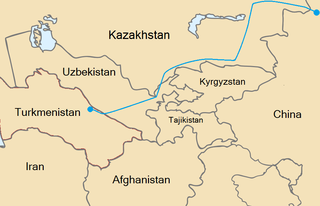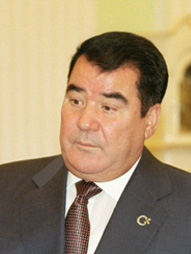Related Research Articles

The economy of Turkmenistan continues to recover from the 2014 downturn in hydrocarbon prices, but remains "in the grip of its worst economic crisis since the immediate post-independence period, driven in part by low gas prices, the suspension of gas exports to Russia between 2016 and 2019...and poor harvests." Former President Gurbanguly Berdimuhamedow at a session of the Cabinet of Ministers on March 11, 2021, called the rate of GDP growth unsatisfactory. When discussing the 2021 government budget, he noted that 2021 would be "as difficult" a year as 2020 had been.

Turkmenistan's declaration of "permanent neutrality" was formally recognized by the United Nations in 1995. Former President Niyazov stated that the neutrality would prevent Turkmenistan from participating in multi-national defense organizations, but allows military assistance. Its neutral foreign policy has an important place in the country's constitution. Although the Government of Turkmenistan claims to favour trade with and export to the United States, Pakistan, and Turkey, its single largest commercial partner is China, which buys the vast bulk of Turkmen natural gas via the Central Asia–China gas pipeline. Turkmenistan has significant commercial relationships with Russia and Iran and growing cross-border trade with Afghanistan. The Government of Turkmenistan often appears to use the conflicting interests of these regional powers as a means to extract concessions, especially on energy issues.

Turkmenistan, also known as Turkmenia, is a landlocked country in Central Asia, bordered by Kazakhstan to the northwest, Uzbekistan to the north, east and northeast, Afghanistan to the southeast, Iran to the south and southwest and the Caspian Sea to the west. Ashgabat is the capital and largest city of the country. The population of the country is about 6 million, the lowest of the Central Asian republics. Turkmenistan is one of the most sparsely populated nations in Asia. Citizens of Turkmenistan are known as Turkmenistanis, Turkmenians or Turkmens.

The Turkmenistan–Afghanistan–Pakistan–India (TAPI) Pipeline, also known as Trans-Afghanistan Pipeline, is a natural gas pipeline being developed by the Galkynysh – TAPI Pipeline Company Limited with participation of the Asian Development Bank. The pipeline will transport natural gas from the Galkynysh Gas Field in Turkmenistan through Afghanistan into Pakistan and then to India. Construction on the project started in Turkmenistan on 13 December 2015, work on the Afghan section began in February 2018, and work on the Pakistani section was planned to commence in December 2018. The abbreviation TAPI comes from the first letters of those countries. Proponents of the project see it as a modern continuation of the Silk Road.

Ahal Region is one of five provinces of Turkmenistan. It is in the south-center of the country, bordering Iran and Afghanistan along the Kopet Dag Range. Its area is 97,160 km2 (37,510 sq mi) and population 939,700.

The Trans-Caspian Gas Pipeline is a proposed subsea pipeline between Türkmenbaşy in Turkmenistan, and Baku in Azerbaijan. According to some proposals it will also include a connection between the Tengiz Field in Kazakhstan, and Türkmenbaşy. The Trans-Caspian Gas Pipeline project is purposed to transport natural gas from Turkmenistan and Kazakhstan to European Union member countries, circumventing both Russia and Iran. It is also considered as a natural eastward extension of Southern Gas Corridor. This project attracts significant interest since it will connect vast Turkmen gas resources to major consumer geographies as Turkey and Europe.

The Central Asia–China gas pipeline is a natural gas pipeline system from Central Asia to Xinjiang in the People's Republic of China. By connecting Turkmenistan to China’s domestic grid, this pipeline makes it possible to transport gas some 7000 km from Turkmenistan to Shanghai. More than half of Turkmen natural gas exports are delivered to China through the pipeline.

The Central Asia – Center gas pipeline system is a Gazprom controlled system of natural gas pipelines, which run from Turkmenistan via Uzbekistan and Kazakhstan to Russia. The eastern branch includes the Central Asia - Center (CAC) 1, 2, 4 and 5 pipelines, which start from the south-eastern gas fields of Turkmenistan. The western branch consists of the CAC-3 pipeline and a project to build a new parallel Caspian pipeline. The western branch runs from the Caspian Sea coast of Turkmenistan to north. The branches meet in western Kazakhstan. From there the pipelines run to north where they are connected to the Russian natural gas pipeline system.
The Galkynysh Gas Field, formerly known as Iolotan gas field or South Yolotan – Osman field, is a large natural gas field near Ýolöten in Mary Province of Turkmenistan. It is the world's second-largest gas field.
Environmental issues in Turkmenistan are most visible in three significant areas: desertification, the drying of the Aral Sea, and chemical pollution. All three of these areas are directly linked to agricultural practices in the country.

Iran and Turkmenistan share a common border of more than 1000km. Since Turkmenistan's independence from the Soviet Union in 1991, the two countries have enjoyed good relations and have cooperated in economic, transportation, infrastructure development, and energy sectors. The two nations have strong historic ties.

Turkmenistan – United States relations are bilateral relations between Turkmenistan and the United States.
The Ministry of Education of Turkmenistan is responsible for Education in Turkmenistan at all levels.

Russia–Turkmenistan relations refers to the bilateral relationship between Russia and Turkmenistan. Russia has an embassy in Ashgabat and a consulate-general in Türkmenbaşy. Turkmenistan has an embassy in Moscow. In 1869 the modern-day Turkmenistani region became absorbed into the Russian Empire. After 1924 it became a Soviet Socialist Republic within the Soviet Union until declaring independence in 1991. The two nations have thus been mutually friendly for the past centuries.

Saparmurat Atayevich Niyazov or Saparmyrat Ataýewiç Nyýazow/Сапармырат Атаевич Ныязов, also known as Türkmenbaşy or Turkmenbashy, was a Turkmen politician who ruled Turkmenistan from 1985 until his death in 2006. He was First Secretary of the Turkmen Communist Party from 1985 until 1991 and supported the 1991 Soviet coup d'état attempt. He continued to rule Turkmenistan for 15 years after independence from the Soviet Union in 1991.
Gökdepe District is a district of Ahal Region, Turkmenistan.

Bilateral diplomatic relations exist between Armenia and Turkmenistan. Armenia is represented in Ashgabat by its embassy Turkmenistan also has its own embassy in Yerevan.
The Dauletabad–Sarakhs–Khangiran pipeline is a natural gas pipeline from the Dauletabad gas field in Turkmenistan to Khangiran in Iran, where it is connected with the Iran Gas Trunkline system. It is significant as it allows the diversification of Turkmenistan's gas export routes, doubling the nation's export of gas to Iran. For Iran, the pipeline allows the country to deal with gas shortages in its northern regions, and to improve its reputation as a trade partner in the Caspian region. Gas began pumping on 3 January 2010, and the pipeline was inaugurated in a ceremony in Turkmenistan on 6 January 2010.

The Darvaza gas crater, also known as the Door to Hell or Gates of Hell, is a burning natural gas field collapsed into a cavern near Darvaza, Turkmenistan.
The geology of Turkmenistan includes two different geological provinces: the Karakum, or South Turan Platform, and the Alpine Orogen.
References
- ↑ Shaban, Ilham (July 3, 2018). "Газоперерабатывающей индустрии Туркменистана – 20 лет" [Gas processing industry of Turkmenistan - 20 years]. Caspian Barrel (in Russian). Retrieved 2021-09-23.